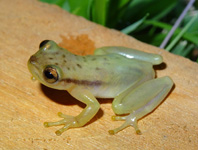Abstract
New species Scoliorhapis stepanovi has been collected from depths of 10–23 m on the sandy bottom of Avacha Bay (east coast of Kamchatka), Paramushir Island (North Kuril Islands), and Matua Island (Middle Kuril Islands). It is unique in having sigmoid ossicles in the body wall with points at both ends (without an open-eye, and with the two points lying in a perpendicular plane). Such sigmoids do not occur in any other taeniogyrinid species. The two-pointed sigmoids are 80–115 µm in length, and are scattered in the body wall and not clustered. Probably the two-pointed sigmoids are underdeveloped typical sigmoid with open-eye. In the tentacles there are straight and C-shaped rods, sometimes branched at the ends, 70–90 µm in length. It is assumed that atypical two-pointed sigmoid ossicles may have been originated due to deviating from the usual course of sigmoid development in the middle stages. Scoliorhapis stepanovi resembles S. lindbergi. A key for species of Scoliorhapis is provided.
References
Clark, H.L. (1908) The Apodous Holothurians: A monograph of the Synaptidae and Molpadiidae, including a report on the representatives of these families in the collections of the United National Museum. Smithsonian Contributions Knowledge 35, 1–231, 14 pls.
Clark, H.L. (1921) The echinoderm fauna of Torres Strait: its composition and its origin. Carnegie Institution of Washington Publication 214 (Papers from the Department of Marine Biology of the Carnegie Institution of Washington 10), 233 pp., 10 pls.
Clark, H.L. (1946) The echinoderm fauna of Australia. Its composition and its origin. Carnegie Institution of Washington Publication, 566, 567 pp.
Djakonov, A.M., Baranova, Z.I. & Saveljeva, T.S. (1958) Zametka o goloturiiakh (Holothurioidea) rayona uzhnogo Sakhalina i uzhnykh Kuril’skikh ostrovov. Issledovaniya dal’nevostochnykh morei SSSR [Note on the holothurians (Holothurioidea) from South Sakhalin and South Kurile Islands. Explorations of the Far-Eastern Seas of the USSR], 5, 358–380. [in Russian]
Heding, S.G. (1928) Synaptidae. Papers from Dr. Th. Mortensen's Pacific Expedition 1914‑16. XLVI. Videnskabelige Meddelelser fra Dansk naturhistorisk Forening i København, 85, 105–323, pls. 2, 3.
Inoue, J. & Kajihara, H. (2012) Redescription of Scoliorhapis lindbergi comb. nov. (Echinodermata: Holothuroidea: Apodida: Chiridotidae), with special reference to the ultrastructure of sigmoid bodies. Species diversity, 71, 15–20.
Kusakin, O.G. (1979) Morskie i solonovatovodnye ravnonogie rakoobraznye (Isopoda) kholodnykh i umerennykh vod severnogo polushariya. Podotr. Flabellifera [Marine and brackish isopods (Isopoda) of cold and temperate waters of the northern hemisphere. Suborder Flabellifera]. (Keys to the Fauna of the USSR, 122). Leningrad: “Nauka”. 472 pp. [in Russian]
Kussakin, O.G. (1990) Biogeography of isopod Crustaceans in the Boreal Pacific. Bulletin of Marine Science, 46 (3), 620–639.
Levin, V.S. (1982) Novye dannye o goloturii Scoliodotella lindbergi (Apoda, Chiridotidae) Zoologicheskii Zhurnal [New data on a sea cucumber Scoliodotella lindbergi (Apoda, Chiridotidae) Zoological Journal], 61 (12), 1916–1920. [in Russian with brief English summary].
Marenzeller, E. von. (1881) Neue Holothurien von Japan und China. Verhandlungen Kaiserlich-Königlichen Zoologisch-Botanischen Gesellschaft, Wien, 31, 121–140, Tafl. 4, 5.
Mortensen, Th. (1925) Echinoderms of new Zealand and the Auckland Campbell Islands. III-V. Asteroidea, Holothuroidea and Crinoidea. Papers from Dr. Th. Mortensen's Pacific Expedition 1914‑16. XXIX. Videnskabelige Meddelelser fra Dansk naturhistorisk Forening i København, 7, 261–420, pls. 12–14.
Oguro, C. (1961) The fauna of Akkeshi Bay XXVI. Holothuroidea. Publications from the Akkeshi Marine Biological Station, 11, 1–4.
Oguro, C. (1965) Notes on the morphology of an apodian holothurian, Scoliodotella uchidai. Publication from the Akkeshi Marine Biological Station, 15, 1–8.
Ohshima, H. (1913) Synaptiden von Misaki. Dobutsugaku zasshi [Zoological Magazine], 25, 253–262. [in Japanese with German summary].
Ohshima, H. (1914) The Synaptidae of Japan. Nihon dobutsugaku iho [Annotationes Zoologicae Japonenses], 8: 467–482, 1 pl.
Ohshima, H. (1919) Holothurians collected by the “Albatross” in the Northwestern Pacific. Dobutsugaku zasshi [Zoological Magazine], 31, 139–149. [in Japan].
O'Loughlin, P.M. & VandenSpiegel, D. (2010) A revision of Antarctic and some Indo-Pacific apodid sea cucumbers (Echinodermata: Holothuroidea: Apodida). Memoirs of Museum Victoria, 67, 61–95.
Rowe, F.W.E. (1976) Restriction of the chiridotid genus Trochodota Ludwig (1891) (Holothurioidea: Apodida), with the description of a new species from South Australia. Transactions of the Royal Society of South Australia, 100 (4), 203–206.
Rowe, F. W. E. & Gates, J. (1995) Echinodermata. In: Wells, A. (ed.). Zoological Catalogue of Australia. Vol. 33. CSIRO, Melbourne, i–xiii + 510 pp.
Semper C. (1867–8). Reisen im Archipel der Philippinen. Zweiter Theil. Wissenschaftliche Resultate. Erster Band. Holothurien. Verlag von Wilhelm Engelmann, Leipzig, 288 S.
Smirnov, A.V. (1998) On the classification of the apodid holothurians. In: Mooi, R. & Telford, M. (eds). "Echinoderms: San Francisco". Proceedings of the ninth international echinoderm conference, San Francisco, California, USA, 5‑9 August 1996. A. A. Balkema, Rotterdam, Brookfield, 517–522.
Smirnov, A.V. (2012) System of the Class Holothuroidea. Paleontological Journal, 46 (8), 793–832.
http://dx.doi.org/10.1134/S0031030112080126
Smirnov, A.V. (2015) Paedomorphosis and heterochrony in the origin and evolution of the class Holothuroidea. Paleontological Journal, 49 (14), 1597–1615.
http://dx.doi.org/10.1134/S003103011514018X
Solis-Marin, F.A., Komatsu, M., Soliman, T., Uchida, K., Shimotani, T. & Nozaki, M. (2014) Scoliorhapis dianthus, a new species of sea cucumber (Apodida: Chiridotidae) from the Sea of Japan. Proceedings of the Biological Society of Washington, 127 (2), 323–327.
http://dx.doi.org/10.2988/0006-324X-127.2.323Stepanov, V.G., Panina, E.G. & Morozov, T.B. (2012) Fauna goloturiy Avachinskogo zaliva (severo-vostochnaia chast’ Tikhogo okeana). Issledovaniya vodnykh biologicheskikh resursov Kamchatki i severo-zapadnoi chasti Tikhogo okeana: Sbornik nauchnykh trudov. [A holothurian fauna of the Avacha gulf (North-West part of Pacific Ocean). Investigation of the Studies of water biological resources of Kamchatka and the North-West Pacific: Proceedings]. KamchatNIRO, Petropavlovsk-Kamchatsky, 26 (1), 12–32.
Studer, T. (1876) Über Echinodermen aus dem antarkischen Meere und zwei neue Seeigel von den Papua–Inseln, gesammelt auf der Reise SMS Gazelle um die Erde. Monatsberichte der königlich Preussichen Akademie der Wissenschaften zu Berlin aus dem Jahre 1876, 452–465.
Théel, H. (1886) Report on the Holothurioidea dredged by HMS. Challenger during the years 1873–1876. Part II. Scientific Results of HMS Challenger 1873–1876. Zoology. Vol. 4, (no. 34), 290 pp., 16 pls.

